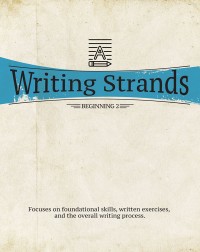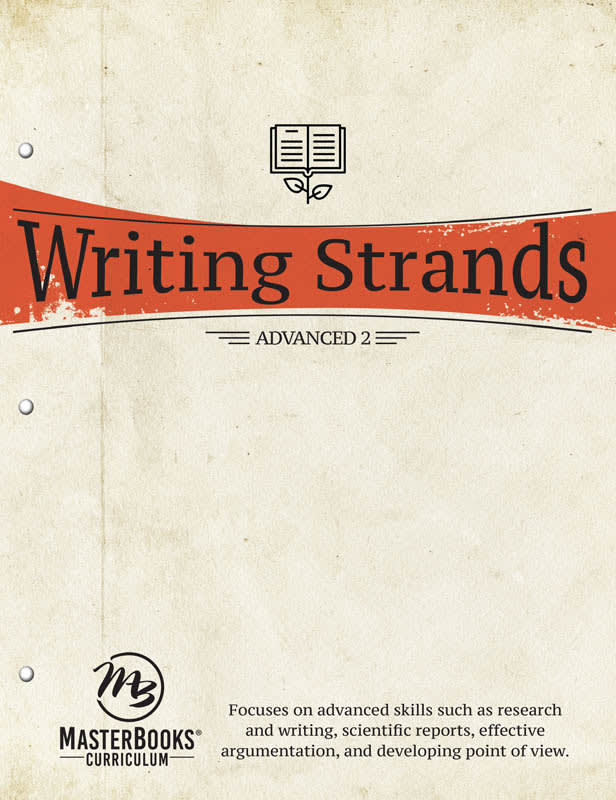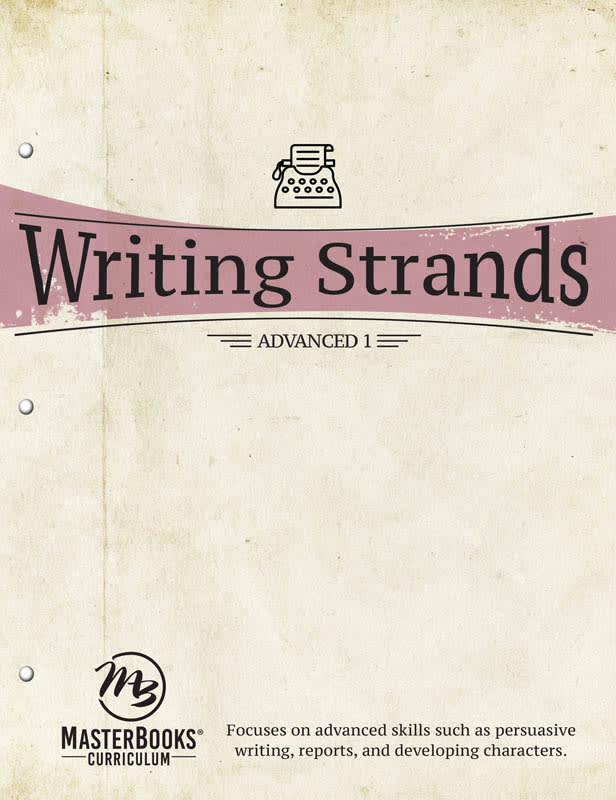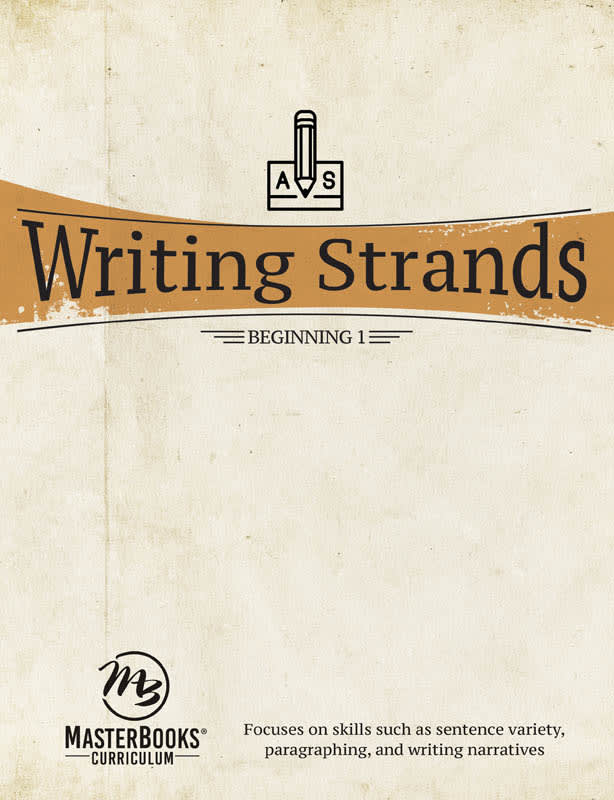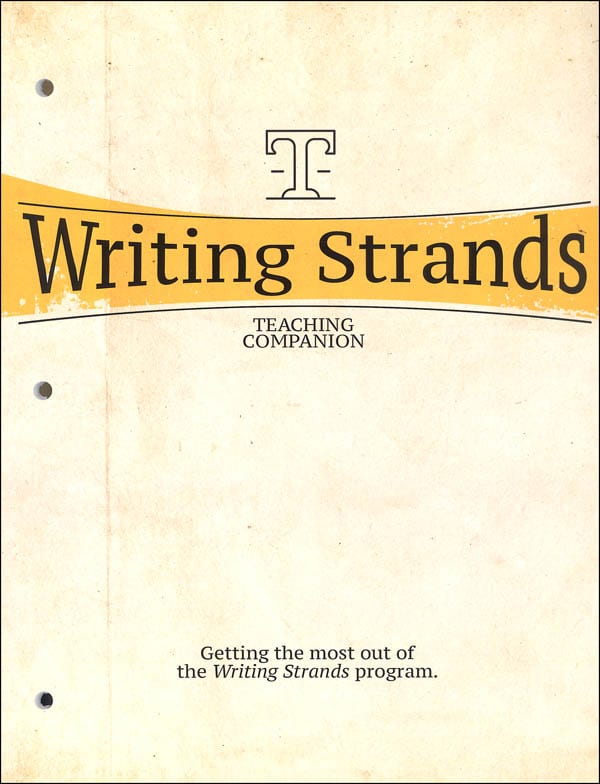Writing Strands was created by Dave Marks in the 1980s, but it has been totally redesigned and rewritten in a new Writing Strands series published by Master Books. While the original series took a secular approach, the new series has strong Christian content throughout.
There are six books in the series:
Beginning 1 (grades 5-8)
Beginning 2 ( grades 5-8)
Intermediate 1 (grades 6-9)
Intermediate 2 (grades 6-9)
Advanced 1 (grades 9-10)
Advanced 2 (grades 9-10)
Each book serves as a complete language arts course for one school year, covering composition and literature. As shown above, each course might be used across a span of grade levels. The publisher's website has placement guidelines that should be useful for helping to determine a student's starting place.
Writing Strands teaches four primary strands of writing across all of the courses: creative, argumentative, report and research, and expository. A fully developed reading strand has been added to the revised series with writing and reading lessons receiving primary attention on alternate weeks. If you prefer, you can choose to teach all of the writing lessons first then teach the reading lessons the second semester. Beginning 1, Beginning 2, and Advanced 1 also devote the final lesson to teaching communication skills.
There are occasional lessons on grammar and usage within student books, but parents will need to review or teach grammar on an as-needed basis. Some students might need more structured grammar instruction, but a resource such as Learning Grammar Through Writing might work well alongside Writing Strands as a self-correctional tool for students who simply need to refresh their knowledge.
There are no teacher manuals for the individual courses. Instead, the Writing Strands: Teaching Companion covers all six courses. It serves as a toolbox rather than a teaching guide. For example, it has sections on “Establishing Goals and Objectives,” “Understanding the Elements of Fiction,” and “Important Terms and Common Problems.” The last section refers to terms and problems commonly encountered in composition and grammar.
The Teaching Companion explains on pages 12 to 15 that spelling instruction is customized for each student based on words with which they struggle. There is one page in each student book that briefly describes the process for recording and studying spelling words, but the Teaching Companion explains it more fully and includes a list of spelling rules. Similarly, vocabulary is to be taught based upon word roots as is explained on pages 48 to 50. There are no instructions for vocabulary in student books.
The tone of the writing lessons in Writing Strands is friendly and easy to understand—more inviting than most textbooks. The content is often presented with unique twists, making it interesting enough to motivate reluctant writers. For example, in Writing Lesson 14 in Intermediate 2, students write a descriptive piece about a house. First, they will describe the house as a new house without directly relating that fact. Then they will write about that same house, but this time the house needs to be described as an old, abandoned house without stating that directly. Writing lessons such as this are broken up into daily assignments to keep students from becoming overwhelmed.
Students will complete a Student Progress Report page when they complete each writing assignment—a self-evaluation tool. Parents will probably want to go over this with their child, and help them note just one or a few problematic areas at a time on a page titled “List of Problems to Solve.” During the course, parents should work with students to resolve those list items.
Bi-weekly reading lessons assign readings from the Bible throughout the first five Writing Strands volumes. In addition, parents will assign another book for reading. This can be a book that can be easily read in less than a week or a book that is read over a number of weeks. The final page of each reading lesson asks general questions in regard to the assigned book. Those sets of questions are different for each course, but they are the same for every reading lesson within each course. Since answering those questions serves as part of the learning material, if a student spends many weeks on just one book, they will not be addressing those questions in light of many different literary works. So I suggest choosing quite a few books from different genres that can be read within a week or two rather than only one or two books that take a few months each to read.
Reading lessons deal with both comprehension and analysis. All of the courses teach a broad range of literary analysis skills, but each focuses especially on one or a few particular topics within both the questions relating to the Bible reading and the general questions for assigned books. Beginning 1 deals with character. Beginning 2 teaches about setting. Intermediate 1 introduces the elements of a story’s plot. Intermediate 2 addresses a number of literary elements such as genre, tone, and point of view. Advanced 1 teaches about figurative language, and Advanced 2 has students apply all of these elements as they study only one book for the entire course, John Bunyan’s Pilgrim’s Progress.
Reading lessons often direct students to “Read and discuss with your teacher.” This instruction is followed by questions with blank lines on which students can write their answers. You can discuss the reading first, then have students answer questions or the reverse. Pages 21 and 22 in the Teaching Companion provide some excellent questions that might be used during discussion to help children think more deeply about what they are reading. Questions and writing assignments within the reading lessons incorporate a significant amount of writing.
The courses are supposed to require about 30 to 45 minutes per day. However, the amount of work assigned each day might vary dramatically. Reading will also take up some additional time. On days when students complete lesson assignments quickly, you might work on vocabulary or spelling.
Students can write directly in the books, although these books do not lie flat. Pages in student books are perforated and three-hole punched so they can be easily removed, handed out as needed, and collected in a binder. However, some lessons end on one side of a page with another lesson beginning on the reverse. Personally, I would probably remove pages to make it easier for students to write, but I would photocopy pages that run into the next lesson. Having pages in a binder also allows you to insert other written work—whether completed on the computer then printed out or by hand—in the binder adjacent to the appropriate lesson.
The original Writing Strands series had loads of great content, but it was poorly organized and difficult to use. The new series is vastly improved, making it much easier for both parents and students to work through the lessons.




